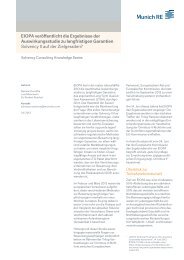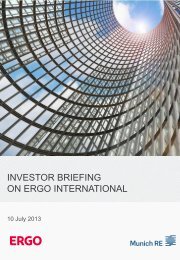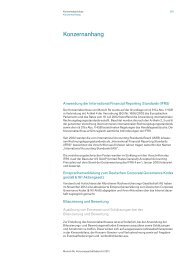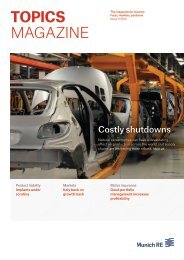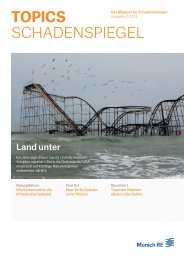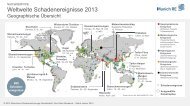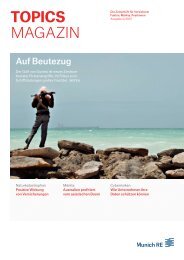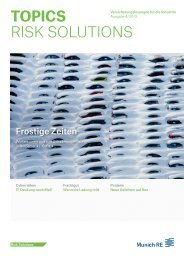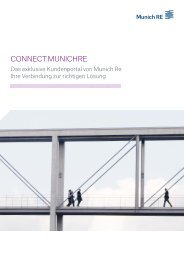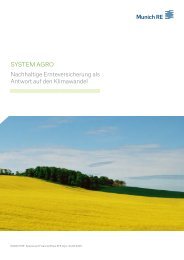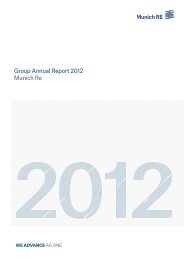Munich Re Group Annual Report 2006 (PDF, 1.8
Munich Re Group Annual Report 2006 (PDF, 1.8
Munich Re Group Annual Report 2006 (PDF, 1.8
Create successful ePaper yourself
Turn your PDF publications into a flip-book with our unique Google optimized e-Paper software.
<strong>Munich</strong> <strong>Re</strong> <strong>Group</strong> <strong>Annual</strong> <strong>Re</strong>port <strong>2006</strong> Management report_Risk report<br />
Board of Management<br />
Approves business strategy<br />
Defines risk appetite and expected risk-adjusted returns<br />
Business management/Risk owners<br />
Business planning<br />
Identify and evaluate risks<br />
Take steps to manage/mitigate all risks associated with their business<br />
Manage and own risks of all approved transactions regardless of ultimate<br />
approval level<br />
Internal Auditing<br />
Audit function independently verifies that effective controls are in place and functioning<br />
Risk appetite and risk-based capital<br />
The basis for accepting risks is determined by the Board<br />
of Management’s requirements and decisions on risk<br />
appetite. These are defined by the <strong>Group</strong>’s strategic risk<br />
management framework (developed in <strong>2006</strong> and implemented<br />
as from 2007) and consider the impact on capitalisation,<br />
liquidity and earnings volatility. They include<br />
“whole portfolio criteria” as well as “supplementary”<br />
criteria designed to limit and steer peak exposures, concentrations,<br />
accumulations and systematic risks across<br />
the <strong>Group</strong>.<br />
We manage business portfolios by assigning return<br />
expectations, derived from the size of the risks assumed, to<br />
individual business activities. Our internal risk model, the<br />
<strong>Munich</strong> <strong>Re</strong> Capital Model, plays a central role here. We use<br />
it to analyse how certain risk scenarios affect the results of<br />
the segments life and health, property-casualty and the<br />
investments of the reinsurance and primary groups. For<br />
the segments life and health, we supplement the risk<br />
metrics from our internal risk model with risk metrics<br />
derived from our market-consistent embedded value<br />
steering framework. This framework allows us to take an<br />
objective view of the risks, tailored to the long-term nature<br />
of that business.<br />
We determine our required economic capital using a<br />
robust market-consistent economic capital model, the<br />
<strong>Munich</strong> <strong>Re</strong> Capital Model. It is calibrated to absorb two<br />
successive annual losses of a size only to be expected<br />
Integrated Risk Management<br />
Clear mandate by the Board to ensure that for all classes of risk<br />
appropriate limits, policies, procedures and measures are in place<br />
within each business unit<br />
Aggregate and monitor <strong>Group</strong>-wide risks (e.g. risk capital) and<br />
report to Board<br />
Develop risk mitigation strategies<br />
every 100 years. The model is built using a series of modules<br />
for each of our business segments. For example, for<br />
our scenarios of natural hazards worldwide, we utilise the<br />
expertise of our geoscience teams, who together with<br />
our Corporate Underwriting unit test and refine external<br />
models and internally-built models to represent our global<br />
exposures to hurricanes, winter storms, typhoons, earthquakes,<br />
flood and other natural perils. The modules are<br />
aggregated using a conservative measure of the dependence<br />
of the risks in the portfolio, and a series of stress tests<br />
are applied to check the resilience of the implied “economic<br />
capital buffer” (i.e. excess of available financial<br />
resources over required risk capital). In the next step, the<br />
required risk capital is allocated to the individual divisional<br />
units on a proportional basis in line with the volatility of<br />
their business activities.<br />
In primary insurance, the procedure is substantially<br />
influenced by other steering aspects, such as supervisory<br />
restrictions and policyholders’ participation in surplus. At<br />
the present time, for our primary insurance operations,<br />
required risk capital is therefore determined at a legal-entity<br />
level, taking these features into account. In reinsurance,<br />
where the majority of our business is written through<br />
<strong>Munich</strong> <strong>Re</strong>insurance Company or one of its branches, we<br />
aggregate risk capital requirements at reinsurance-segment<br />
level. In this way, we evaluate the <strong>Munich</strong> <strong>Re</strong> <strong>Group</strong>’s<br />
risk capital with regard to the fungibility of risk and capital.<br />
125



